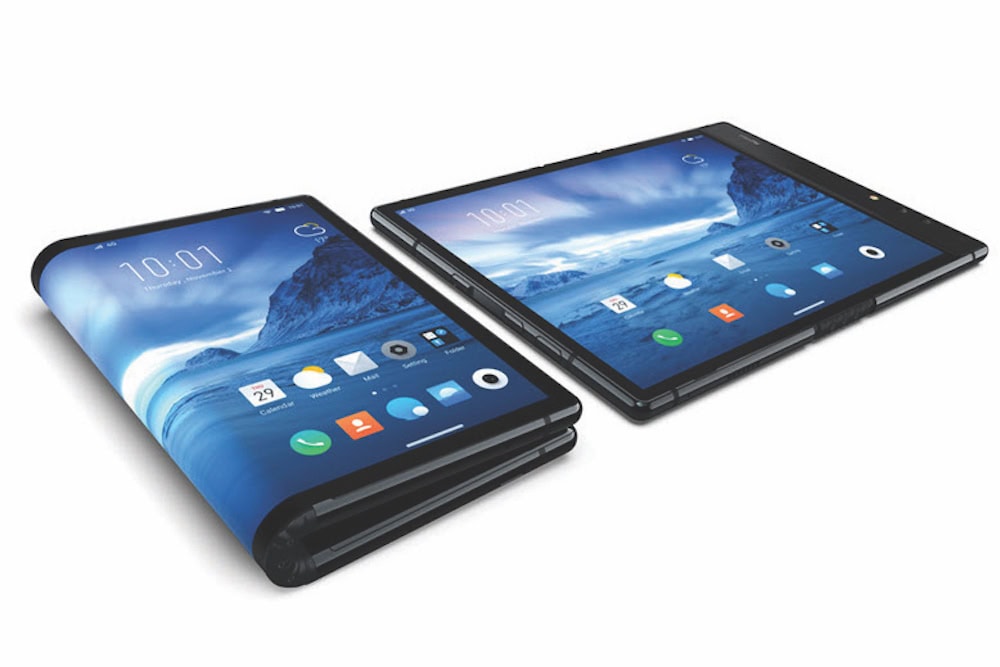
[Image above] Royole Corporation’s FlexPai is one example of a possible foldable smartphone. There are several challenges foldable smartphones must face if they are to work as well as traditional smartphones. Credit: Royole Corporation
Smartphones are quite the technological achievement. Not only do they place calls, smartphones act as cameras, GPS, portable music devices—even tell time—all in the palm of a hand. Yet smartphones still can’t do one thing very well: bend.
That fact might soon change.
Samsung, Huawei, Lenovo, Xiaomi, and LG all released plans for foldable smartphones this year, and one company, Royole Corporation, produced a working prototype that they hope to release before the end of the year. These foldable phones would be a step beyond current foldable phones because, instead of two separate screens attached by a hinge, these phones would feature a single screen that bends. There are several reasons this is desirable, including easier scrolling and viewing when the phone is opened all the way (no hinge interruption).
However, despite the hype surrounding the anticipated deployment of these products, there are several technological challenges that make it likely these first foldable phones might not perform as well as their traditional, non-bending counterparts.
Cover glass
One of the big difficulties in creating a foldable smartphone is the cover glass, the outermost layer of glass on a smartphone. Smartphone screens consist of several layers of glass and electronics embedded between the layers. Many of the flexible glasses discussed in the media—like Corning’s Willow Glass—are used for the inside glass layer. These glasses are not used for the cover glass—they are not tough enough to protect the sensitive electronics from accidental drops on the floor.
Conventionally, a tough cover glass is a rigid cover glass, and rigid glasses cannot bend or fold without fractures or breakage. A report by Samsung stated they will not use Corning’s Gorilla Glass—a popular glass used for cover glass—on their foldable smartphone for this reason.
Instead of glass, many first foldable smartphones will likely use plastic for the cover screen. Plastic is the route Samsung plans to go, according to reports that Samsung picked Japanese electronic materials firm Sumitomo Chemical as the sole supplier of polyimide (PI) films, a transparent plastic film. However, there are drawbacks to using plastic instead of glass.
“It’s a material reality that anything that conforms [like plastic] will be more susceptible to scratches,” says Mark Rolston, founder and chief creative at product design firm argodesign, in an interview with CNET. Additionally, plastic does not keep oxygen and water out as well as glass.
Touch screen technology
The two main ways touch screens detect your finger is through either capacitive sensing or piezoelectric sensing. Both types of sensing use electrical signals to tell the screen how to react. While the distribution of electric signals on capacitive screens are controlled by applying an external electric charge (the electrons on your fingers), the distribution of electric signals on piezoelectric screens are controlled by an internal electric charge (the crystals in the screen generate electrical energy when pressed).
In both the capacitive and piezoelectric screens, the strength of the electric signal is determined by how hard the screen is pressed. As such, touch sensing works best if the screen does not move from one specified shape and the only change in the screen’s mechanical stress comes from you pressing on the screen. If the screen can fold, though, the screen’s mechanical stress will change during the folding, making it more difficult for the screen to accurately tell how hard you press. Therefore, bendable smartphones will likely feature only pre-specified bends—where the screen’s mechanical stress is known for each shape—and not be floppy, rollable scrolls (though some researchers are trying).
There is ongoing research to improve touch sensor technology, such as this recent article by professor Jun-Bo Yoon and his coworkers from the Korea Advanced Institute of Science and Technology. In their research, Yoon and his coworkers developed a thin, flexible, and transparent hierarchical nanocomposite film that uses a soft grating and hard insulator to concentrate the pressure-related stress to the gratings, thereby enhancing sensitivity.
Battery
In a foldable phone, all the components—not just the glass—must bend. This can be troublesome, particularly with respect to the phone’s battery.
In an interview with CNET, Marc Juzkow, vice president of research and development for battery company Leyden Energy, says today’s smartphones are usually powered with lithium-ion batteries, whose stiffness maximizes the time a smartphone can hold a charge. While new battery technology is moving toward thin, flat cells based on solid-state electrolytes, Juzkow says these batteries’ energy output cannot run a smartphone for as long as a traditional battery.
Until new battery technologies are designed, foldable smartphones must bend at fixed points, to avoid bending in areas containing the rigid battery and other inflexible parts.
The biggest challenge of all
Despite the challenges associated with making foldable smartphones perform as well as traditional smartphones, there is no doubt that the technology will improve with each new foldable smartphone edition released. The bigger challenge facing smartphone companies now is a marketing one: why do you (the consumer) want or need a foldable smartphone? Most companies have only a few months left to answer to this question, as many of the planned foldable smartphones are expected to debut in 2019 and will be more expensive than a traditional smartphone. Royole Corporation’s FlexPai (available for pre-order now) costs over $1,300, and Samsung’s Galaxy F is projected to cost almost $2,000.
For those interested in more information on smartphones and smartphone technology, watch for the December issue of the ACerS Bulletin coming out next week. The feature article this month is about how glass and ceramics help put the “smart” in smartphones!
Update 11/14/18: Mark Rolston’s attribution was updated to reflect his current title and position
Author
Lisa McDonald
CTT Categories
- Electronics

